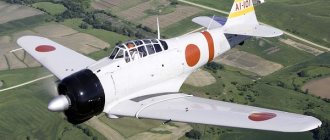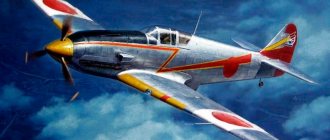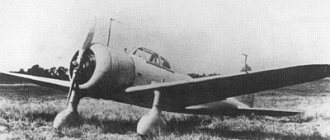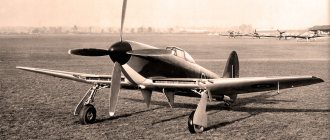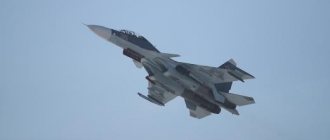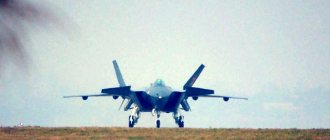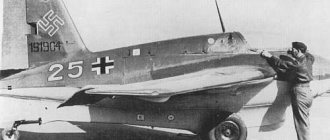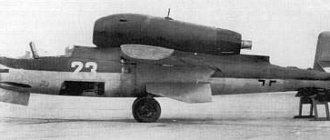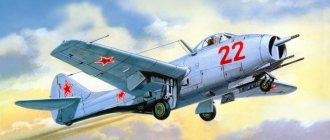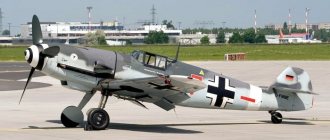Kawasaki Ki-61 Hien fighter
The Kawasaki Ki-61 fighter with the gentle name “Swallow” stood out sharply among the fighters of the Japanese Imperial Army - it was equipped with a liquid-cooled engine, while all other aircraft of a similar purpose had star-shaped engines cooled by air. The prerequisite for this was the acquisition by Kawasaki of a license for the German DB 601 A engine, the production of which was launched in Japan in the second half of 1941 under the designation Xa-40. The engine was ideal for an interceptor fighter, characterized by a high wing load, robust design and powerful weapons - the creation of such an aircraft was considered necessary based on the experience of the conflict at Khalkhin Gol. A similar task, as applied to aircraft with air-cooled engines, was solved by creating, in addition to the “standard” Ki-43, the Ki-44 “Demon” interceptor. Kawasaki was commissioned to create a pair of aircraft with X-40 engines - the Ki-60 interceptor and the “standard” Ki-61 fighter.
Initially, the Ki-60 had priority, but the appearance of the Ki-44 alleviated the problem of providing Japanese aviation with an interceptor during World War II. In this regard, the attention of designers turned to the Ki-61, which has a wider range of possible applications. The vehicle differed from the Ki-60 by its wing area increased by 25% (the profile was the same), as well as by a much greater mass.
Kawasaki Ki-61 Ib
Work under the leadership of T. Doi and S. Owada was carried out very quickly - the Ki-61 prototype first took to the air on December 11, 1941. Even before this, the company received instructions to prepare mass production of the aircraft. This decision seemed risky, but the risk paid off - flight tests showed high performance characteristics of the aircraft, superior in speed parameters to all competitors (including the captured Soviet LaGG-3 and American Curtis P-40E), and in maneuverability second only to the Ki-43 II. In addition, the Ki-61 had protection unprecedented for Japanese fighters - protected fuel tanks and an armored backrest for the pilot's seat. As a result, the aircraft was put into mass production at a plant in Gifu. In total, including prototypes and pre-production aircraft, 2,878 aircraft were built. In the Allied code system it was designated "Tony".
Main modifications of Kawasaki Ki-61
Ki -61 - pre-production aircraft. Engine X-40. Armament: 2 12.7 mm type 1 synchronized machine guns (Ho-103) and 2 7.7 mm type 89 wing machine guns. Until August 1942, 10 copies were built, slightly different in detail, since the equipment for production had not yet been fully prepared.
Ki -61 IA (“army fighter aircraft type 3 model 1a”) is the first production modification, built since August 1942. The engine and armament corresponded to pre-production vehicles. Until September 1943, 388 units were produced.
Ki -61 I B (“type 3 model 1b”) - instead of 7.7 mm machine guns, 12.7 mm are installed in the wing. By April 1944, 592 were produced.
Ki -61 1S ( “type 3 model 1s”) - a variant with cannon armament. Since the wing design of the Ki-61 was not suitable for mounting Japanese 20-mm Ho-5 cannons, the aircraft were initially equipped with 2 German MG 151/20 cannons (at the end of August 1943, an Italian submarine delivered 800 of these cannons to Penang). The fuselage machine guns remained the same. Subsequently, a new wing with reinforced spars was used on the Ki-61 1C - this made it possible not only to install Ho-5 cannons, but also to hang 2,250 kg aerial bombs or 2,200-liter PTB under the wing. Until July 1944, 400 Ki-61 1C aircraft were produced.
Ki -61 I Kai A and Ki -61 I Kai B - Ki-61 IA and Ki-61 IB aircraft, which received a new wing with 20-mm Ho-5 cannons. 388 vehicles were converted - partly at the Gifu plant, partly directly in parts by factory repair teams.
Ki -61 I D (“type 3 model 1d”) - a deep modernization of the Ki-61, taking into account the experience of combat use. The fuselage is somewhat lengthened, and its tail section is detachable. Control has been significantly simplified, many components have been lightened, and the tail wheel is made non-retractable. Armament: 2 12.7 mm machine guns in the fuselage and 2 20 mm Ho-5 cannons in the wing. Some of the aircraft received two 30-mm Ho-105 cannons in the wing, but they turned out to be too heavy for the Ki-61, and they were replaced by the Ho-5. The prototype was tested in January 1944, and mass production began in February. Until March 1945, 1354 aircraft were produced.
Ki -61 II - X-140 engine (1500 hp). The armament corresponded to the Ki-61 ID. The wing area has been increased (up to 22 sq. m) and the fuselage has been lengthened. Until August 1944, 33 vehicles were built, including 3 prototypes. The plane turned out to be unsuccessful - wing flutter often occurred, and the engine mount was too weak for a more powerful engine.
Ki -61 II Kai (“type 3 model 2”) - the aircraft combined the fuselage and engine of the Ki-61 II and the wing of the Ki-61 ID. There were two weapon options - the standard Ki-61 II Kai A (2 12.7 mm machine guns and 2 20 mm cannons) and the reinforced Ki-61 II Kai B (4 20 mm Ho-5 cannons). 99 aircraft were produced from August 1944 to May 1945, although much more gliders were produced - due to the lack of X-140 engines (in January 1945, the Akashi engine plant was completely destroyed due to bombing), most were converted into Ki-100 . Of the 99 aircraft built, about 30 were made in the Ki-61 II Kai V variant.
The Ki-61 III variant (“type 3 model 3”), which was a deep modernization of the aircraft for the X-240 engine (1800 hp), did not enter mass production. In addition, the aircraft was to receive a new teardrop-shaped cockpit canopy, which significantly improved visibility. Due to the unavailability of the new engine, several gliders with a teardrop-shaped canopy were equipped with Kha-140 engines (such machines were designated Ki-61 II Kai S). The production of an “economy version” of the Ki-61 IE with a wooden fuselage tail and tail section was also being prepared. The vehicle passed tests, but they refused to introduce it into the series, deciding to focus on the more promising Ki-100.
Fighter
Kawasaki
© Mikhail Bykov
Ki-61-Ib of the commander of the 244th Sentai (air regiment) Major T. Kobayashi, April 1945.
The Ki-61 Hien (Swallow) fighter was a unique machine among Japanese combat aircraft of the Second World War. It was equipped with an inverted V-shaped piston engine Na-40, which was a licensed version of the German Daimler-Benz DB-601A engine.
The first prototype of the Ki-61 was manufactured in December 1941 and successfully passed flight tests, showing good maneuverability and controllability in the air. True, compared to the Ki-43, the fighter had a fairly high specific wing load (146 kg/m2), but this disadvantage was fully compensated by powerful weapons, protected gas tanks and armor protection of the vehicle. The maximum speed of the Ki-61 at an altitude of 6000 m was 591 km/h. To conduct military tests, she built 11 more prototypes, but even before their completion, an order was received for mass production of the fighter.
The Ki-61 entered service with the Japanese army at the end of 1942 and, in accordance with the Japanese designation system, received the name “army fighter type 3 model I”, as well as the name “Hien” (Swallow). By the end of the year, the Kagamihara plant produced 34 serial fighters in two versions: Ki-61-la (armed with two 12.7-mm synchronized fuselage machine guns No-103 and two wing-mounted 7.7-mm Type 89 machine guns) and Ki- 61-Ib (four No-103 machine guns of 12.7 mm caliber in the wing and fuselage).
The Ki-61-I fighter began to enter service in February 1943; in total, about 1,380 aircraft were produced in two versions, differing in their armament. After this, another 1,274 Ki-61 KAI fighters appeared with an extended fuselage and various weapon combinations.
Further developments led to the creation of the Ki-61-II KAI high-altitude fighter, powered by the Na-140 engine. The new Hien was the only Japanese fighter capable of operating effectively at high altitude against the B-29 Superfortresses, but poor engine reliability reduced its combat value to a minimum.
A total of 374 of these aircraft were built, again in two versions with different weapons, but only 99 of them were equipped with the Na-140 engine. Like other Japanese fighters, the Hien was soon no longer able to withstand its American opponents.
Flight characteristics of the Kawasaki Ki-61 IA aircraft
- Engine: Kawasaki X-40
- power, hp: 1175
- Wingspan, m.: 12
- Aircraft length, m: 8.74
- Aircraft height, m: 3.7
- Wing area, sq. m.: 20
- Weight, kg:
- empty aircraft: 2210
- takeoff: 2950
- maximum takeoff: 3250
- Maximum speed, km/h / at altitude, m: 584/4820
- Climb time 5000, min.: 5'31"
- Ceiling, m.: 10900
- Flight range, km. (with PTB): 600 (1100)
Combat use of the Kawasaki Ki-61
The introduction of the Ki-61 into combat units required a special approach, since the vehicle had no continuity with any other type of fighter in the Imperial Army. In addition, the hasty introduction of the aircraft into series led to the fact that the units ended up with rather “crude” aircraft with a whole bunch of “childhood diseases”. Therefore, for rearmament, first of all, units from relatively calm Manchuria were chosen - they could be taken to Japan for several months. At the beginning of 1943, the 68th and 78th Sentai mastered new aircraft in this way, and after retraining they went to New Guinea. The Ki-61's combat work began in mid-May 1943. The aircraft primarily performed air defense missions, and their main opponents were the B-24 Liberator and B-25 Mitchell bombers, accompanied by the P-38 Lightning fighters. Powerful weapons, good survivability and high dive speed allowed Ki-61 pilots to successfully use hit-and-run tactics. However, our own losses were very significant, and mainly not in air battles, but from enemy attacks on airfields. At the end of August it was even necessary to replenish the Sentai with Ki-43 fighters. Subsequently, the establishment of production and supply of the Ki-61 made it possible to replenish parts. The 68th and 78th Sentai fought in New Guinea until mid-1944. On July 25, 1944, both units were disbanded due to the loss of all aircraft.
Since September 1944, the 17th and 19th Sentai, armed with Ki-61, fought in the Philippines. In October, Okinawa and Formosa were attacked by American carrier-based aircraft; Ki-61s from training units took part in repelling these attacks. The further development of American operations in the Philippines forced the Japanese command to strengthen its aviation group in the region - in mid-November 1944, the 18th and 55th Sentai, armed with Ki-61, arrived there. But the efforts were in vain - in January 1945, air battles over the Philippines practically ceased, and the Americans established complete air supremacy. In the Philippines, the Ki-61 proved to be a very good fighter, although it was inferior in flight performance to its American counterpart. They were able to achieve the greatest success by operating in large groups (up to 24 aircraft) against bombers - this was also facilitated by the powerful cannon armament of the Ki-61. But as the Sentai fleet dwindled, the Ki-61 pilots found it increasingly difficult to counter the American fighters.
The Ki-61 was most widely used in the air defense system of the Japanese Islands. Here at least six Sentai were acting on them at the same time, including several recreated after the evacuation from the Philippines. The most famous was the 244th Sentai, which covered Tokyo. By the end of the war, this unit accounted for 102 B-29s shot down and 192 damaged. In addition to the usual tactics, from December 1944, Ki-61 pilots began to use the Shinten Seikutai (Striking Sky) ramming tactics. At the same time, we were not talking about suicidal attacks - it was supposed to cause damage to an American bomber with a ramming attack, after which the fighter pilot had to either land his damaged aircraft or bail out. The battle was based on close interaction between “ram” fighters and conventional ones, which made it possible to achieve success. However, since April 1945, thanks to the capture of Iwo Jima, the Americans were able to accompany their Boeing B-29 superfortress bombers with North American P-51 fighters - this sharply reduced the effectiveness of Japanese fighters.
In April-May 1945, Ki-61 took part in Operation Kikusui - massive kamikaze attacks on the American fleet off Okinawa. The Ki-61 aircraft were considered too valuable to waste on suicide attacks, so they were used very rarely as kamikazes. The main task of the Ki-61 was to cover the kamikazes going on the attack. This function was assigned to the 59th Sentai. However, the limited range of the Kawasaki Ki-61 Hien led to the fact that their pilots were forced to abandon their “wards” at the most difficult moment - on the approaches to the target. Three Ki-61 Sentai based in Formosa also took part in the battles in the Okinawa area.
In June-July 1945, the activity of units armed with the Kawasaki Ki-61 decreased significantly - they suffered serious losses in previous battles, and the production of aircraft of this type ceased. In addition, there was an order prohibiting engagement with superior enemy forces - the Ki-61 was being saved to repel the expected American invasion of the Japanese Islands. By the end of July, there were 53 Ki-61s in Japan in the 18th, 55th and 56th Sentai.
Kawasaki Ki-61 - the only Japanese fighter with a liquid-cooled engine
A number of Ki-61s from units stationed in Formosa and mainland China became trophies of the Kuomintang troops. They were concentrated at the Nanyuan airfield near Beijing, but the Kuomintang probably did not have time to use the Ki-61 in battle, and the planes were captured by the Communists.
In general, the Kawasaki Ki-61 should be considered a successful machine. It became the first Japanese fighter, not too inferior in armament and protection to enemy aircraft. At the same time, the vehicle retained the “trademark” feature of other Japanese fighters - high maneuverability. In addition, the Ki-61 was one of the few Japanese aircraft that maintained high flight performance at high altitudes.
Today we will get acquainted with such a wonderful device as the Ki-61 otsu.
Ki-61 - Japanese second-rank fighter. The main opponents are La-5F, Yak-3, Cobra and sometimes Spitfire. And if we start comparing, then in terms of speed in the horizon and acceleration dynamics we are inferior to everyone. In terms of maneuverability, everything is not so bad, but in a turning battle we only win 100% of the Cobras; the rest will have problems.
Let's move on to the actual disassembly of the aircraft.
Advantages of Ki-61
Three aspects can be distinguished from the advantages of this device. 1. Excellent speed gain in a dive, thanks to which our game tactics are based. As a matter of fact, if the Ki-61-I otsu can do anything well, it is to dive and catch up with the enemy. The speed gain is simply phenomenal; only selected Cobras can escape us. Therefore, from the very beginning of the battle it is worth gaining height, without it nothing will happen to us. 2. Moderate maneuverability. The Ki-61 is still not designed for turning combat, since due to its small wing area and weak engine, it is simply not capable of withstanding a battle against the more thrust-armed Yak or Spitfire. However, in the case of fighting Cobras, one lap is enough for us to get them “six”. That is, turning combat is possible only with “log aircraft” and only if there is speed. It is recommended not to take turns, so as not to drain the energy that is important to us. 3. A huge amount of ammunition. This is the most ridiculous plus. It is quite difficult to destroy an airplane with Japanese “peas”; you can pour buckets of lead on it and everything will be useless. Let's say “thank you” to the Japanese designers for the excellent rate of fire and ballistics of the Ho-103 machine guns.
Disadvantages of the Ki-61
1. Terrible dynamics at altitudes up to 4 km. The plane cannot gain speed in level flight. On the ground, average values are only 400-450 km/h. For the second era this is very little. We take into account the loss of speed during any defensive maneuver and come to the conclusion that it is not worth going down. This needs to be kept in mind constantly. 2. Bad machine guns. Shooting from them is complete randomness - it is not clear where the projectile is flying, what the spread and piercing effect are. It’s almost impossible to pick someone up in one go, except perhaps to “plant” them in the cockpit, but that depends on your luck.
Let's sum up the intermediate results. The Ki-61-I otsu dives well when gaining speed, can maneuver against some enemies, but at the same time, it is absolutely helpless without height and its armament leaves much to be desired.
Game tactics for Ki-61
There are few options, or rather just one - boom-zoom and rare turns depending on the circumstances. 1. Initially, you should gain 5-5.5 km of altitude, that is, from the beginning of the battle you need to climb slightly to the side. 2. Next, we play boom-zoomer and maintain the height as much as possible. 3. After all these actions, when we need to shoot down at least someone, we select one enemy and try to force him into a dive. Well, of course, he won’t be able to get away from the Ki-61. 4. Next we act according to the situation. Either we quickly kill him and go back to the height, or we make a beautiful loop and repeat the attack. 5. As for turns, the advice here is clear - it’s better to avoid them. Some cases include finishing off a previously downed enemy, encountering a “log plane,” covering an ally, etc. In such situations, you can engage in maneuver combat.
From all this we can conclude that the aircraft is designed for combat from heights - boom-zoom, attacks on aisles, hanging the enemy, and so on.
Recommendations for Ki-61
1. It is recommended to install a tracer or air tape. This, of course, is not a panacea for Japanese miracle machine guns, but they have a good chance of setting the enemy on fire, depending on your luck. 2. It is better to set the climb degree in the region of 10-15, in afterburner. There is no need to worry about overheating - the plane can withstand 6 minutes of active flight, which is approximately equal to 5-6 kilometers of climb. 3. Frontal attacks should be avoided. Although we have four machine guns, their spread and low second salvo do not allow us to inflict any damage on the enemy.
Conclusion. The Ki-61 is not a plane for everyone. It has too many disadvantages that cannot be covered by the climb alone. Playing the Ki-61 is boring and monotonous. And when machine guns don’t cause damage, the gameplay turns into eating a cactus. And now we invite you to watch a video guide on the Ki-61-I-otsu aircraft, which was prepared by Libertus:
Share information with friends:
